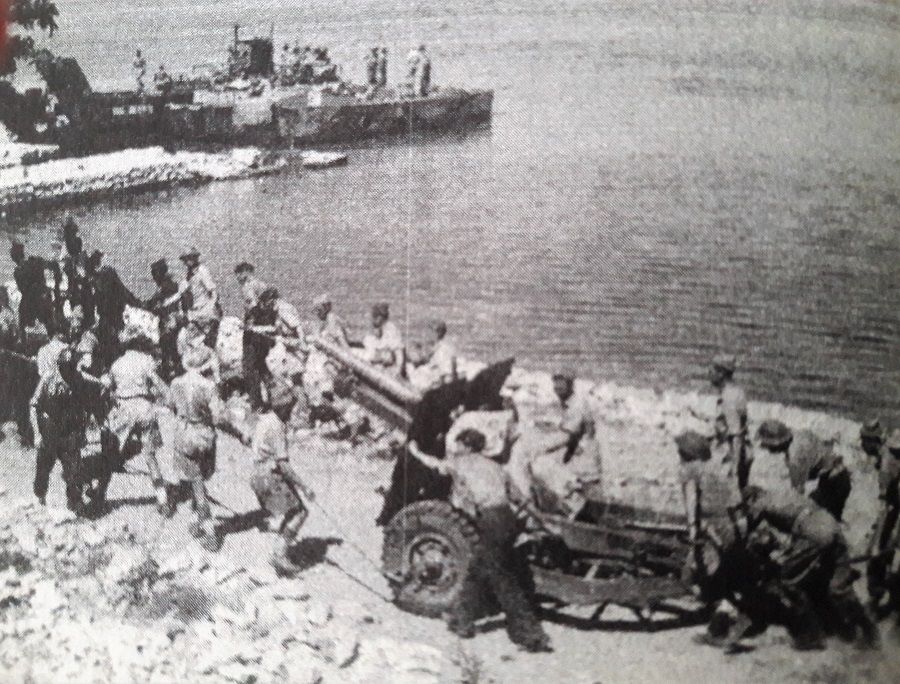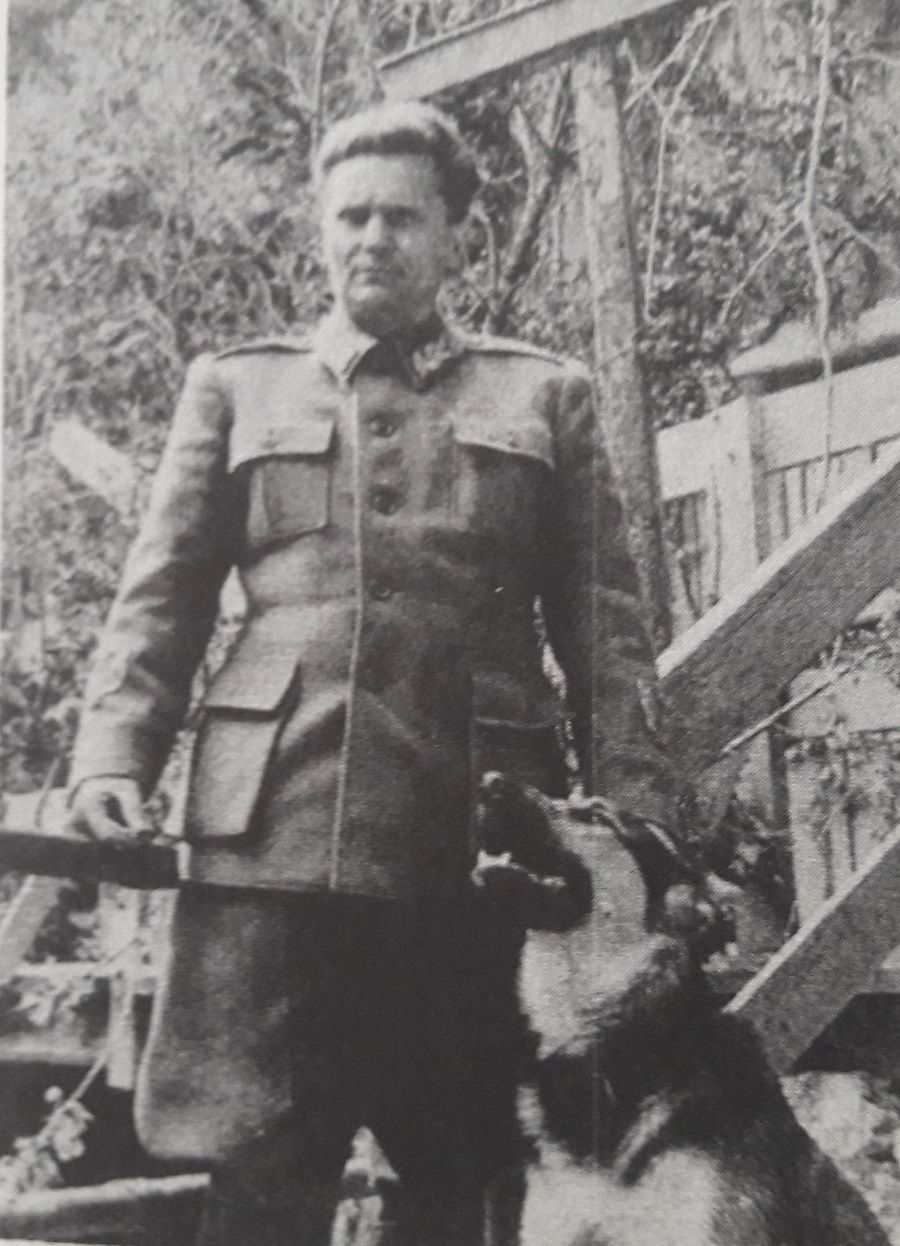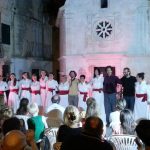July 28, 2018 – Fourth and final piece from Frank McGinley on the occupation, resistance and liberation of the island of Hvar during World War II.
Neda and her daughter are finishing breakfast on their terrace when a menacing drone invades the stillness of the pjaca. As the noise increases, fearful of the trigger-happy fighter aircraft that come over at rooftop height, she clutches at the child dragging them both down into the shelter of the parapet wall. The church-fortress in the centre of the pjaca is an obvious target. As the din increases to a raucous roar, the German vehicles thunder into the square, motorcycles and staff car rounding the church steps and halting at their gate. In old age, the child, Stjepana, will recall this scene exactly: the outriders in their goggles and leathers, the officer with the SS shoulder flashes on his black uniform, the eagle and swastika on peaked cap and helmets, the broken cups and plates on the stone tiles of the terrace, the dog barking his head off as she drags him back into the house. It is October 1943. The Italians have capitulated, and the Germans have landed in force on Hvar. They are determined to prevent the Allied forces on Vis from threatening their southern flank. They are billeting troops in villages around the island.
During the months that followed, Neda and the child took refuge in a bare stone dwelling by the cove where the family kept their boat. Their menfolk had long departed. From there at night the sounds of battle grew nearer. They heard gunfire close at hand as troops from Vis raided Vrboska, then detonations from the bombs and rockets as fighter bombers attacked the nearby harbours and eventually the thump of artillery and clatter of heavy cannon as the Germans were first driven out of the nearby port of Jelsa, then returned and were driven out again.
By May 1944, there were more than 10,000 troops on Vis, including Royal Marine Commandos 40 and 43, a Battalion of Highland Light Infantry, US Special Forces, and the Partisans’ 1st and 13th Dalmatian Brigades (including several hundred men and women from Hvar). An airstrip had been laid out to accommodate a flight of Hurricanes and Spitfires. The Allied Commanders were indeed considering capturing Hvar and Brač to create a logistical “bridge” between Vis and the mainland.
Their planning was disrupted when the Germans suddenly struck a massive blow against Tito at his HQ in Drvar in Western Bosnia. At dawn on 25 May, five squadrons of Junkers bombers flattened the town, preceding an airborne attack by a full Battalion of SS Paratroopers. Simultaneously, the whole region was encircled by German and NDH troops. Tito escaped the immediate attack but still had to fight his way out of the wider trap that was being set. British SOE officers attached to his HQ radioed the news to Vis. Tito was demanding that all Partisan units attack the Germans wherever they could and pleaded for similar action from the British. On Vis, British and Partisan Commanders agreed an immediate response: an amphibious attack on the island of Brač. It was to become the biggest Allied action in Yugoslavia during the entire war. The following is drawn from Commando records at the National Archives in Kew.

At 02.00 on 1 June, B Company, HLI Battalion, were landed from Partisan schooners skirting round Hvar to Blaca cove on the South-West side of Brač. Trained in mountain warfare at Cameron of Lochiel’s fastness in the Scottish Highlands (where Bonnie Prince Charlie raised his standard), the HLI task was to knock out an Observation Post on Vidova Gora, the highest point on the island, providing the Germans a clear view of the intended Allied landing zones along the south coast.
The Jocks climbed up over the limestone ridges, each man carrying 60 lbs of weapons and supplies, and laid up for the rest of the day. At 23.59, they attacked the German Observation Post, under heavy fire from concrete emplacements on which their mortar and sten gun fire had little effect. They cut the German telephone wires, fell back, reformed, and made a further determined attack, but were repulsed with heavy casualties. They had run into a barbed wire enclosure, heavily mined, surrounding the German position. All of their officers and NCO’s were either wounded or killed. Under mortar and spandau fire, they withdrew, making their way down the scree and winding tracks assisted by Partisan guides.
The main forces were landed unobserved at 00.30 on 2 June. 13 Ptzn Brigade (1,500 strong) with 43 Cndo and elements of 40 Cndo (400 strong) were dry-landed from Infantry Landing Craft at Blaca. The main task of this group was to destroy the German Command Post on a hilltop near Nerežišća in the centre of the island of Brač, overlooking their garrisons at Supetar on the north side and Sumartin at the eastern end of the island. 1st Ptzn Brigade (1,400 strong) landed at Bol with the task of preventing the Germans from emerging from Sumartin. From first light and throughout the day, the Partisans attacked Nerežišća and, after calling in air strikes from the Spitfires at Vis, 43 Cndo and Ptzns, with artillery and mortar support, made a more determined attack but failed to take their objective.
The Commandos were led by the highly decorated and somewhat eccentric Lt Col Jack Churchill (no relation to the Prime Minister). That evening he called in reinforcements and overnight the remainder of 40 Cndo with 300 more Partisans were landed. Churchill drew up a plan for a further attack which he was unable to agree with the Partisans. The Commandos therefore carried out the assault that night by themselves. Due to faulty communications, they reached their start lines at different times. 43 Cndo’s attack was launched at 21.15 and pursued with great determination but after gaining part of the hill they were driven back. An hour later, Churchill, having given his orders to 40 Cndo at foot of the hill, led them on a further attack, playing his bagpipes as was his wont. 40 Cndo briefly took the German position and success signals were fired. The Germans reacted at once with mortar fire and counterattacked. Two troop leaders of 40 Cndo were killed and their Lt Col mortally wounded. LtC Churchill, also wounded, was last seen on one knee playing his pipes as his troops withdrew at 06.00.
The Cndo log gives reveals little detail of the bloody battle. The Germans had learned from British and Partisans raids on Hvar. No longer were their troops billeted in schools and houses. Their new dispositions at Nerežišća, as at Vidova Gora and key positions on other islands, consisted of an inner circle of rock and concrete firing positions linked by trenches and surrounded by minefields within barbed wire enclosures. It was a killing zone. Nevertheless, the Cndos had breached the barbed wire, crossed the minefields and engaged the enemy in their trenches until, under murderous fire and out of ammunition, they broke off, dragging their wounded with them.
Evacuation began at 0600 that morning and a couple of hours later the combatants were back on Vis without further loss.

(British troops loading artillery onto a Landing Craft)
The raid was judged to have achieved its objective, though it would have done so without the imperative to destroy the Command Post. The Germans were forced to send reinforcements to the coast to counter the attack on Brač. The British flew Tito out to Bari and thence to Vis where he temporarily set up his HQ. But a heavy price was paid. Churchill and 35 of his men were taken prisoner by the Germans. The Cndos had lost their senior officers and nearly all their troop leaders, 16 men in all. Many of their 250 wounded would never fight again. The Partisans, who reported 130 Germans killed and 130 taken prisoner, lost 200 missing. The British concluded that there was no longer any need to capture Hvar and Brač as a bridgehead to supply the Partisans on the mainland. The tide had turned. The biggest Allied landings.
The Germans clung on in Hvar. By August, Partisan and Commando raids had driven them to the East end of the island. On 5 September, in a last attempt to recapture Stari Grad, 400 troops of the Brandenburg Battalion landed at Rudine and re-occupied the town, driving out hundreds of refugees, looting all the houses and stores of food and destroying all the boats in the harbour. The news reached Vis immediately and on 7 September, a large force, including 43 Commando, tanks and artillery, landed in Hvar town. The Brandenburg troops withdrew to Jelsa. As they attempted to move under cover through the fields between Vrboska and Jelsa, they were attacked and routed by a Partisan detachment based at Svirće. Those who escaped fled into Jelsa and seized whatever craft they could to find to escape. Out at sea they were relentlessly attacked by Spitfires from Vis. From their refuge not far away, that was the last that Neda and her daughter saw and heard of them.
The remnants held out at Sućuraj until 22 December when the Partisans overran their artillery post at and they withdrew to the mainland. The Partisans now had full control of the Southern Dalmatian islands. Neda, Stjepana and her neighbours were able to return to their houses on the pjaca and eventually rejoined by husbands and sons who had joined the Partisans or been held in labour camps. They were among the lucky ones; many others would remain until the end of the war in the refugee camps to which they had been forced to flee.
The names I have used are those of imagined, not real, people. It would be insensitive and invidious to name real names. The names and pictures of those of opposing allegiances do exist in the well-documented accounts of the time but I think it better to make value judgments about the loyalties of people who did live through those times in a work of fiction.

(Tito at Drvar)
Tito’s forces were now partners of the Allies recognised, with the Government in Exile, as having the right to form the government of a liberated Yugoslavia. But the islanders were not natural Partisan supporters. Many shared the nationalist views of the Croatian Peasant Party (HSS) which sought independence from a Serb- dominated Yugoslavia. Most were devout Catholics, who hated Communism. Hitler had wanted the HSS leader, Vladko Maček, rather than Pavelić, as head of his puppet state. Maček, an anglophile, refused and was imprisoned, though he encouraged Party members to co-operate with the NDH. The Catholic Church meanwhile made the serious error of judgement (to put it mildly) of accepting the role of State Church and thus being implicated in the genocidal crimes perpetrated on Serbs, Jews and Roma during the NDH reign. On Hvar, many of the clergy, especially the Franciscans in Hvar town, were Ustaša zealots, though some parish priests ended up as pastors to the Catholics among the Partisans.
However, from the moment of its creation, Pavelić’s Ustaša Government started losing support. The Rome Treaty which Pavelić, as Poglavnik, signed with Mussolini on 18 May 1941, added Split, Šibenik and most of islands to Istria and Zadar which the Italians already possessed. For Dalmatians, this was a betrayal. After the Italian capitulation, these territories should have reverted to Croatia but instead were occupied by the Germans in their bid to prevent an Allied landing. The Partisans were increasingly seen as liberators from German occupation. At no point did the Ustaša Militia function as anything other than an instrument of the Wermacht and by 1943, the larger Domobran (Home Guard) forces were deserting wholesale to the Partisans (hence the expression “Domobran by day; Partisan by night”).
Once he had had got rid of the Germans, Croatians began to see the other side of Tito as he set about eliminating his internal rivals with Stalin-esque ferocity. The worst crime was the the massacre of the huge column of Ustaše troops and civilians attempting to flee from the Zagreb area towards Bleiberg in May 1945. The Poglavnik had ordered his troops not to surrender and to withdraw in full military order. As such, they were a fair target for the Partisans. Pavelić was aware that the Allies had agreed with Tito that NDH troops should surrender to the Partisans. The British knew that this , in the words of one General “would not be good for their health, ” but they were in any case simply unable to accommodate, feed or even control the numbers that were fleeing Zagreb. These included tens of thousands of civilians whom Pavelić had warned would otherwise be massacred by the Partisans. It is hard to avoid the conclusion that Pavelić himself had arranged this withdrawal to cover his own ignominious escape and that he shares with Tito the responsibility for this dreadful crime.










